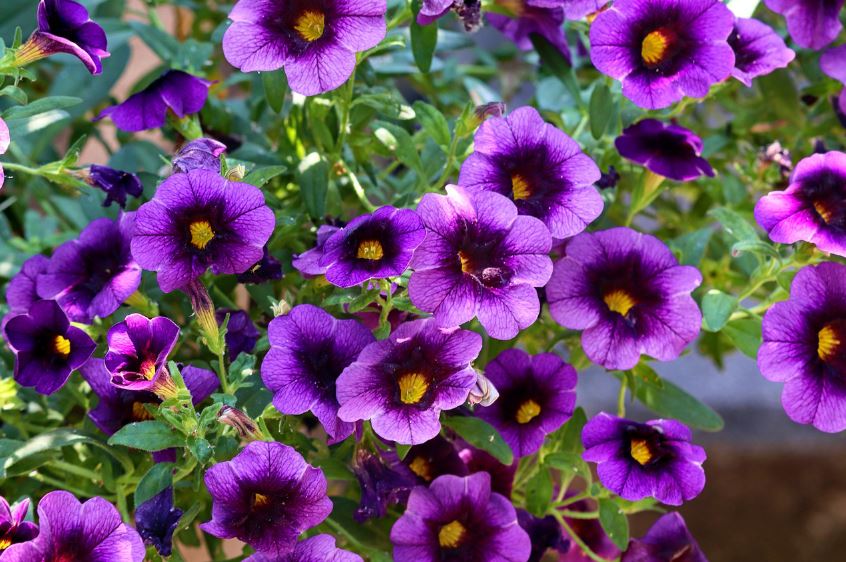When to sow the petunia?
The petunia sows as early as February, under cover. For a sowing in place, let the last frosts pass and wait for the earth to warm up (May / June).
Which varieties to choose?
Single or double flower, dwarf, bushy, creeping or drooping, pink, mauve, white or variegated … There are dozens of varieties of petunias! Some of the most popular varieties include:
- The Dwarf Petunia Grandiflora is one of the most widespread. Its charm: flowers – single or double – whose diameter can reach 10 cm. This semi-creeping variety has only one weak point: it does not appreciate the rain. In regions with a capricious climate, it is best grown in pots, sheltered from an awning;
- The Petunia Multiflora withstands bad weather And with its bushy habit, it lends itself well to the realization of massive. Its flowers – single or double – have a diameter of about 5 cm. Its foliage, very compact, has the particularity of being sticky. It offers a wide choice of colors;
- The Falling petunia is ideal for beds or to decorate a pergola. This medium flowering variety – about 5 cm in diameter – enjoys rapid growth. It can reach up to 2 m. There is a wide choice of colors, theAvalanche Red with vermilion flowers probably offering one of the most spectacular variations.
The choice will depend mainly on the location you reserve for it and the desired effect.
What to do before sowing the petunia (preparation etc)?
The petunia loves a light and well-drained soil. So we will work the land on at least 20 cm, adding if necessary peat or sand. If you are growing in a pot or planter, plan gravel or clay pits to ensure optimal drainage during watering.
How to sow it?

Hot sowing
To take full advantage of the long flowering period of the petunia, we usually opt for early sowing, hot. The ideal is to opt for buckets or for a terrine, at the bottom lined with gravel to guarantee a good drainage. To promote the success of your seedlings, prepare a mix of seed potting soil and potting soil.
The technique is simple:
- Fill the pits with potting soil;
- Place some petunia seeds in each scoop;
- Tamp lightly;
- Water in a fine rain so as not to disturb the seeds.
Place the scoops in a warm and bright place. You can put a glass or plastic plate on top. Wait, May / June to install the seedlings outside.
If you want to install your seedlings in the ground, plan a spacing of 20 to 30 cm. Prepare a generous diameter hole and mix of 50% soil and 50% potting soil. Be careful to handle the plants with care so as not to break them.
Sowing in place
If you choose to plant in place, you must first mix the soil with a seedbed. Petunia seeds sow on the surface. For better visibility, you can mix the seeds with a little sand. After sowing, tamp and sprinkle finely.
Where to plant petunia?
The petunia needs light to produce brightly colored flowers. It will therefore prefer a sunny location, but it will also accommodate the partial shade. It will be enjoyed in a pot, in a planter, on a window, terrace or balcony, or in the garden, on the edge or in the mountains. One imperative: to offer a location protected from the wind.
To compose an original balcony or window decoration, it is possible to associate the petunia with other flowers. It is important to keep in mind that the petunia has a long flowering period. To succeed in your effects, it is wise to plant it with a flower whose flowering is as long, for example the diascia. The waterfall petunia will marry gladly with the begonia or the aster.
If we consider the petunia as an ornamental flower above all, it will find its place in the kitchen garden. It will be placed near the potatoes to keep the potato beetles at bay. It is also an excellent companion plant for protecting susceptible crops of cutworm (the moth larvae), such as lavender or squash.
How to maintain it?
Petunia requires little maintenance. To enjoy a flowering more abundant, you can bring him a fertilizer for flowering plant once a week. Eliminate the flowers as they fade, not hesitating to prune the bare branches half of the stem: this will encourage new ramifications.
Good to know: grown as annuals, petunias are well and truly perennials. If you grow them in pots, you can winter them in a cool and dry place until next spring!
How to water the petunia?
The petunia requires regular watering – daily in summer, when it is very exposed to the sun – and abundant. Despite its abundant and sticky foliage, it will be watered by positioning the watering can well at the base of the plant. Because if it is superb, the petunia has a particular unpleasant feature, especially on a window or on the balcony: it feels very strong when wet.
Petunia diseases and what to do?
Petunia fears little disease. On the other hand, it is a delicacy for slugs. It is therefore wise to protect seedlings, using traps or natural solutions, such as crumbled egg shells. Petunia also attracts aphids. To protect it, you can opt for natural options: use the nasturtium, which will make diversion, or ladybugs.
Read also :









